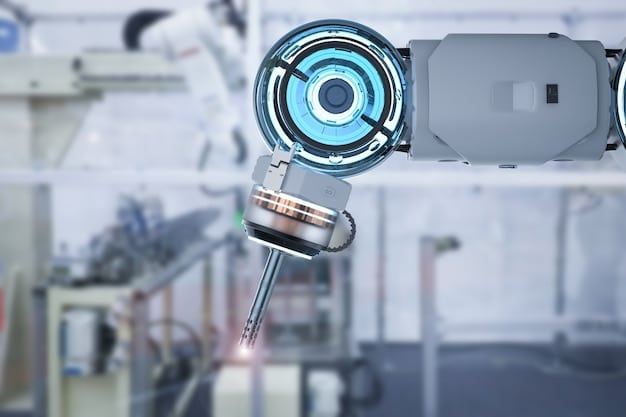Automation’s Impact: Business Productivity in 2025

The Role of Automation in Enhancing Business Productivity: A 2025 Perspective highlights how businesses are leveraging automation technologies like AI, machine learning, and robotic process automation to streamline operations, improve efficiency, and gain a competitive edge in the rapidly evolving business landscape.
As we approach 2025, the impact of automation on business productivity is becoming increasingly profound. Understanding the role of automation in enhancing business productivity: a 2025 perspective is no longer optional; it’s a strategic imperative for survival and growth in a competitive market.
The Automation Evolution: A 2025 Overview
The landscape of business is constantly transforming, and automation stands as a pivotal force in this evolution. By 2025, we anticipate automation to be even more deeply integrated into the fabric of businesses, transcending basic tasks to influence strategic decision-making and create entirely new operational paradigms. Let’s explore what this looks like.
But what specific advancements and adoptions should businesses be prepared for?
AI-Powered Automation
Artificial intelligence (AI) is already revolutionizing many industries, and its role in automation will only continue to grow. AI-powered automation can handle complex tasks that previously required human intervention.
The Rise of Hyperautomation
Hyperautomation, the orchestrated use of multiple technologies, including robotic process automation (RPA), AI, and machine learning, will be essential for businesses seeking radical improvements.
- Enhanced Efficiency: Automating repetitive tasks allows employees to focus on more strategic and creative activities.
- Reduced Costs: Automation can lead to significant cost savings by reducing the need for manual labor and minimizing errors.
- Improved Accuracy: Automated systems are less prone to human error, resulting in more accurate and reliable outcomes.
- Scalability: Automation enables businesses to scale operations quickly and efficiently, adapting to changing market demands.
In summary, the evolution of automation by 2025 will be marked by its deeper integration, enhanced capabilities, and strategic importance in driving business productivity.

Key Technologies Driving Automation
Several key technologies are at the forefront of this automation revolution, each contributing unique capabilities that enhance business productivity. Understanding these technologies is essential for businesses looking to leverage automation effectively. So, what are the pivotal technologies driving this change?
Let’s dive into each of them.
Robotic Process Automation (RPA)
RPA involves using software robots to automate repetitive and rule-based tasks. These robots can mimic human actions, such as data entry, form filling, and report generation, freeing up employees to focus on more complex activities.
Artificial Intelligence (AI) and Machine Learning (ML)
AI and ML enable systems to learn from data and make intelligent decisions without explicit programming. These technologies are used in a wide range of automation applications, from chatbots and virtual assistants to predictive analytics and autonomous systems.
- RPA Applications: Automates routine administrative tasks, reducing manual labor.
- AI & ML Integration: Enables systems to learn from data, improving decision-making.
- Cloud Computing: Offers scalable and cost-effective automation solutions.
The convergence of these key technologies is driving a new wave of automation, enabling businesses to achieve unprecedented levels of productivity and efficiency. As these technologies continue to evolve, their impact will only grow stronger.
Impact on Different Business Functions
Automation is not confined to a single department; its influence extends to various functional areas of a business, reshaping how each operates. Let’s explore the impact of automation across different functions to understand its pervasive influence.
How does automation revolutionize core business functions?
Finance and Accounting
In finance and accounting, automation streamlines processes such as invoice processing, reconciliation, and financial reporting. AI-powered systems can detect anomalies, prevent fraud, and ensure compliance with regulatory requirements.
Human Resources
Automation transforms HR functions by automating recruitment processes, onboarding, and employee training. Chatbots can answer employee queries, manage benefits enrollment, and provide personalized support, improving employee satisfaction and efficiency.

Customer Service
AI-powered chatbots and virtual assistants provide instant support to customers, resolving queries, processing orders, and handling complaints. Automation ensures consistent and personalized service, improving customer satisfaction and loyalty.
- Finance and Accounting: Streamlines invoice processing and financial reporting.
- Human Resources: Automates recruitment and employee training.
- Customer Service: Provides instant support and personalized service.
The impact of automation on various business functions is profound, leading to increased efficiency, reduced costs, and improved customer satisfaction. By embracing automation, businesses can optimize their operations and gain a competitive edge in the market.
Overcoming Challenges in Automation Implementation
While the potential benefits of automation are significant, implementing it successfully is not without challenges. Businesses must navigate various hurdles to ensure automation projects deliver the desired outcomes. What are the common implementation challenges?
Let’s break them down.
Integration Issues
Integrating new automation technologies with existing systems can be complex and time-consuming. Compatibility issues, data migration challenges, and system downtime can disrupt operations and delay implementation.
Data Security and Privacy
With the increasing reliance on data-driven automation, ensuring data security and privacy is paramount. Businesses must implement robust security measures to protect sensitive information from cyber threats and comply with data protection regulations.
Skills Gap
Implementing and managing automation technologies requires specialized skills and expertise. Businesses may face a shortage of skilled professionals who can design, deploy, and maintain automated systems.
In overcoming these challenges, businesses can unlock the full potential of automation and achieve their productivity goals. Strategic planning, investment in training, and collaboration with technology partners are essential for successful automation implementation.
Future Trends in Automation
The future of automation is dynamic and ever-evolving, with several key trends shaping its trajectory. As technology advances, new opportunities and possibilities emerge for businesses seeking to enhance productivity and efficiency. Let’s explore some of the future trends in automation.
What innovations will drive the next wave of automation?
Edge Automation
Edge automation involves deploying automation technologies closer to the source of data, enabling real-time processing and decision-making. This trend is particularly relevant for industries such as manufacturing, logistics, and healthcare, where latency and bandwidth limitations can hinder traditional automation approaches.
Low-Code/No-Code Automation
Low-code/no-code automation platforms empower business users to create and deploy automated solutions without extensive coding knowledge. These platforms democratize automation, enabling citizen developers to solve business problems and drive innovation.
- Edge Automation: Enables real-time processing and decision-making.
- Low-Code/No-Code Automation: Empowers business users to create automated solutions.
- Sustainable Automation: Focuses on energy-efficient and environmentally friendly solutions.
Sustainable Automation
As concerns about climate change and environmental sustainability grow, businesses are increasingly focusing on sustainable automation solutions. These solutions aim to reduce energy consumption, minimize waste, and promote environmentally friendly practices.
Preparing Your Business for Automation in 2025
To thrive in the age of automation, businesses must proactively prepare themselves. This involves adopting a strategic approach to automation, investing in the right technologies, and fostering a culture of innovation and continuous improvement. What steps can businesses take to prepare for automation?
Here are some key strategies.
Assess Current Processes
Businesses should begin by assessing their current processes to identify areas where automation can have the greatest impact. This involves analyzing workflows, identifying bottlenecks, and quantifying the potential benefits of automation.
Invest in Training and Development
To succeed with automation, businesses must invest in training and development programs for their employees. This includes providing training on new technologies, fostering digital literacy, and promoting a culture of continuous learning.
Foster Collaboration
Successful automation initiatives require collaboration between IT, business units, and external partners. Businesses should foster cross-functional teams to ensure alignment, knowledge sharing, and effective communication throughout the automation journey.
| Key Point | Brief Description |
|---|---|
| 🚀 RPA Implementation | Automating repetitive tasks improve overall efficiency. |
| 🤖 AI-Driven Solutions | AI enhances decision-making and customer interactions. |
| 💰 Cost Reduction | Automation leads to substantial cost savings. |
| 🔒 Data Security | Ensuring robust data protection in automated systems. |
Frequently Asked Questions
▼
AI will enable more sophisticated automation, handling complex tasks previously requiring human intervention, such as data analysis, decision-making, and personalized customer experiences.
▼
Hyperautomation is the use of multiple advanced technologies (like RPA, AI, and ML) to automate end-to-end processes, offering radical improvements in efficiency and decision-making.
▼
Businesses can address the skills gap by investing in training programs for employees, partnering with technology providers, and fostering a culture of continuous learning to upskill their workforce.
▼
The main challenges include integrating new automation technologies with existing systems, ensuring data security and privacy, and addressing the shortage of skilled professionals.
▼
Data security is critical because automation relies on data. Businesses must protect sensitive information from cyber threats and data protection regulations, preventing breaches and maintaining trust.
Conclusion
In conclusion, the role of automation in enhancing business productivity: a 2025 perspective is significant. Businesses that proactively embrace automation and address its challenges will be well-positioned to thrive in the evolving business landscape, achieving new levels of efficiency, innovation, and competitive advantage.





